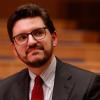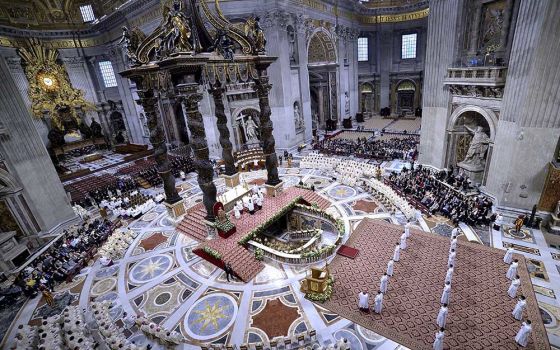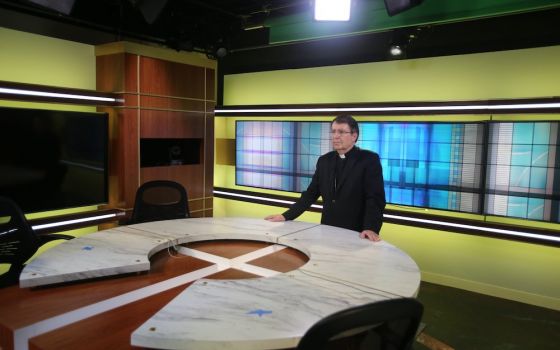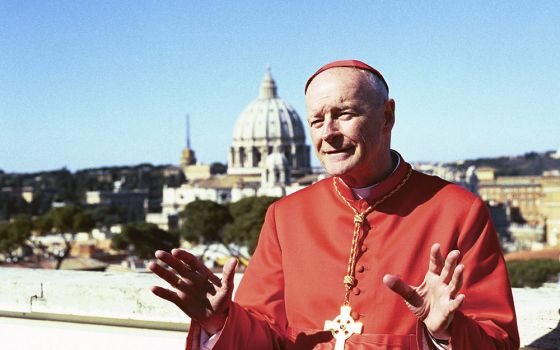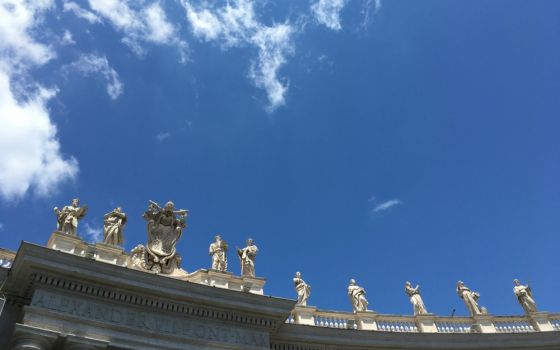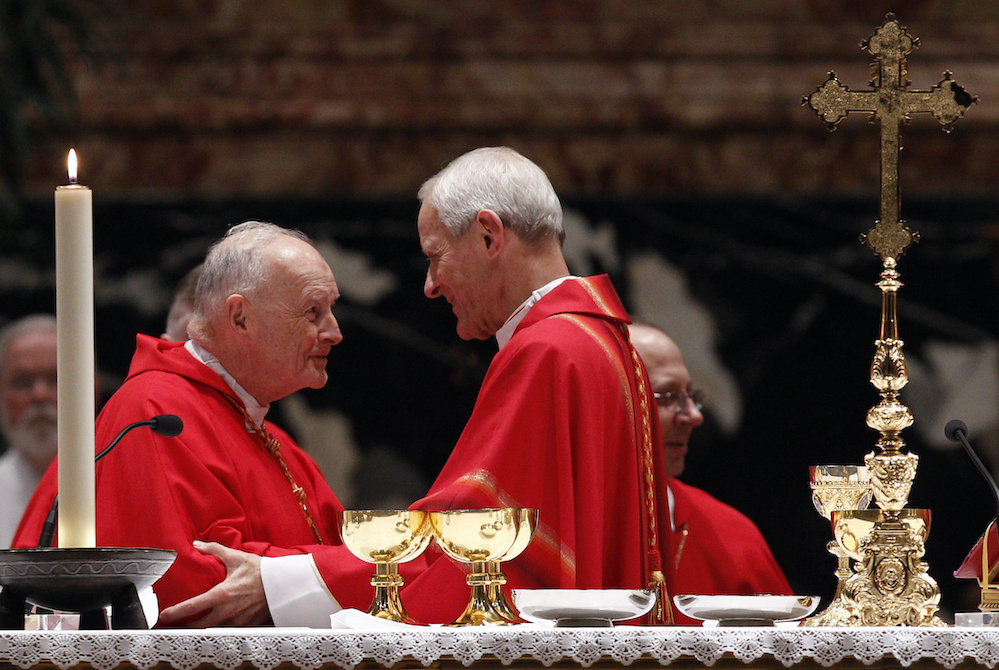
Cardinal Donald Wuerl of Washington, D.C., right, greets then-Cardinal Theodore McCarrick, retired archbishop of Washington, during the sign of peace at a Mass of thanksgiving in St. Peter's Basilica at the Vatican Nov. 22, 2010. (CNS/Paul Haring)
The Vatican's report on the rise of ex-Cardinal Theodore McCarrick, set to be released Nov. 10, will likely contain the names of a vast array of figures — some who were directly involved in the success of his now-disgraced career and others who were ancillary but influential.
To help in preparing for the report's release, NCR has assembled short biographical sketches of some of the more major figures.
McCarrick, aged 90, was long one of the most influential prelates in the U.S. Catholic Church — before a series of shocking announcements in June 2018 revealed that he had been ordered by the Vatican to step down from active ministry after an allegation of sexual abuse was found "credible and substantiated."
Pope Francis confirmed McCarrick's removal from the priesthood, after a guilty finding by the Vatican's Congregation for the Doctrine of the Faith, in February 2019.
For this roster, we have focused primarily on the periods surrounding McCarrick's episcopal appointments, namely: as auxiliary bishop of New York in May 1977, as bishop of Metuchen, New Jersey, in November 1981, as archbishop of Newark in May 1986 and as archbishop of Washington, D.C., in November 2000.
The data included was taken from publicly available sources. The glossary begins with a description of the two key Vatican offices involved, continues with the offices' leaders and concludes with a focus on U.S. cardinals who had unusual influence during the periods in question.
Major Vatican offices
Congregation for Bishops
The Congregation for Bishops is the Vatican office that is primarily tasked with advising the pope on which priests to appoint as bishops in the Latin rite Catholic Church. It is led by a cardinal prefect, who is supported in his role by several dozen members of the congregation. Those members, normally cardinals and archbishops from dioceses around the world, usually play an enormous role in determining who will become bishops in their home countries.
Details of the historic membership of the congregation are available only in the official Vatican yearbook, known as the annuario pontificio, which is released annually and only available in hardcover. For reasons of research time, queries for details of the Congregation's membership were limited to the specific years McCarrick was appointed as bishop: 1977, 1981, 1986 and 2000.
Secretariat of State
Traditionally seen as the highest and most important office in the Vatican bureaucracy, the Secretariat of State handles both the major internal affairs of the bureaucracy and the Vatican's foreign relations. It is led by a cardinal secretary, who is essentially the number-two official of the global Catholic Church and usually a reigning pontiff's closest advisor.
Advertisement
Figures from the Vatican's Secretariat of State
Cardinal Jean-Marie Villot
A French priest, theologian and seminary rector, Villot was made coadjutor Archbishop of Lyon by John XXIII in 1959. Pope Paul VI made him a cardinal in 1965, appointed him as prefect for the Congregation for Clergy in 1967, and then Secretary of State in 1969. Paul gave Villot an expanded portfolio, naming him also as the president of the Pontifical Commission for Vatican City State and of the Administration of the Patrimony of the Holy See.
Among other postings, Villot was also serving as a member of the Congregation for Bishops in at least 1977 and 1978, when McCarrick was made auxiliary bishop of New York.
Popes John Paul I and II both retained Villot as Secretary of State, but he died at age 73 in 1979.
Cardinal Agostino Casaroli
The son of a tailor from Italy's northern Emilia-Romagna region, Casaroli gained a reputation as a skilled diplomatic negotiator through the 1960s, when he was part of teams representing the Vatican in talks with Tunisia, Hungary and communist Czechoslovakia.
Pope John Paul II made Casaroli a cardinal in 1979 and named him Secretary of State, where he served until 1990. Among other postings, Casaroli was also serving as a member of the Congregation for Bishops for at least 1981 to 1987, when McCarrick was appointed to both of his dioceses in New Jersey.
Casaroli was vice-dean of the College of Cardinals from 1993 until his death in 1998.
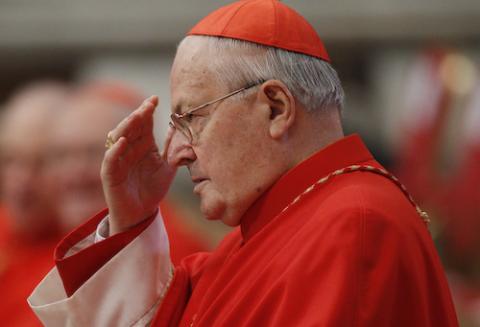
Cardinal Angelo Sodano, then dean of the College of Cardinals, makes the sign of the cross during a Mass celebrated by Pope Benedict XVI in St. Peter's Basilica at the Vatican, Nov. 21, 2010. (CNS/Paul Haring)
Cardinal Angelo Sodano
The son of a noted member of the Italian parliament, Sodano was ordained a priest in 1950 and joined the Vatican's diplomatic service in 1959. He subsequently led a career marked by numerous, high profile roles, among them: Apostolic nuncio to Chile (1977-1988), Vatican foreign minister (1988-1990), Vatican Secretary of State (1991-2006), and Dean of the College of Cardinals (2005-2019).
Sodano was one of Pope John Paul II's most trusted advisors, and abuse victims have long alleged that he pressed the late pontiff to ignore or cover up the crimes of notorious abusers, particularly the late Fr. Marcial Maciel, founder of the Legion of Christ.
Pope Francis accepted Sodano's resignation as Dean of the College of Cardinals Dec. 21, 2019, the same day that the Legion released a list of 33 priests and 71 seminarians accused of abuse.
Cardinal Tarcisio Bertone
A former professor of moral theology and canon law from Italy's Piedmont region, Bertone was appointed to lead the relatively small archdiocese of Vercelli by Pope John Paul II in 1991. He held that post for only four years, moving to the Vatican in 1995 to serve as the second-in-command to Cardinal Joseph Ratzinger (the future Pope Benedict XVI) at the Congregation for the Doctrine of the Faith.
John Paul II later named Bertone the archbishop of Genoa in 2002 and made him a cardinal in 2003.
Pope Benedict brought Bertone back to Rome in 2006, naming him Sodano's successor as the Vatican's Secretary of State. His tenure at the Secretariat, which ended in 2013 under Pope Francis, was noted for a number of controversies. The most prominent was likely the Vati-leaks scandal, which saw the release in January 2012 of secret Vatican documents that appeared to show the blackmailing of gay clergy.
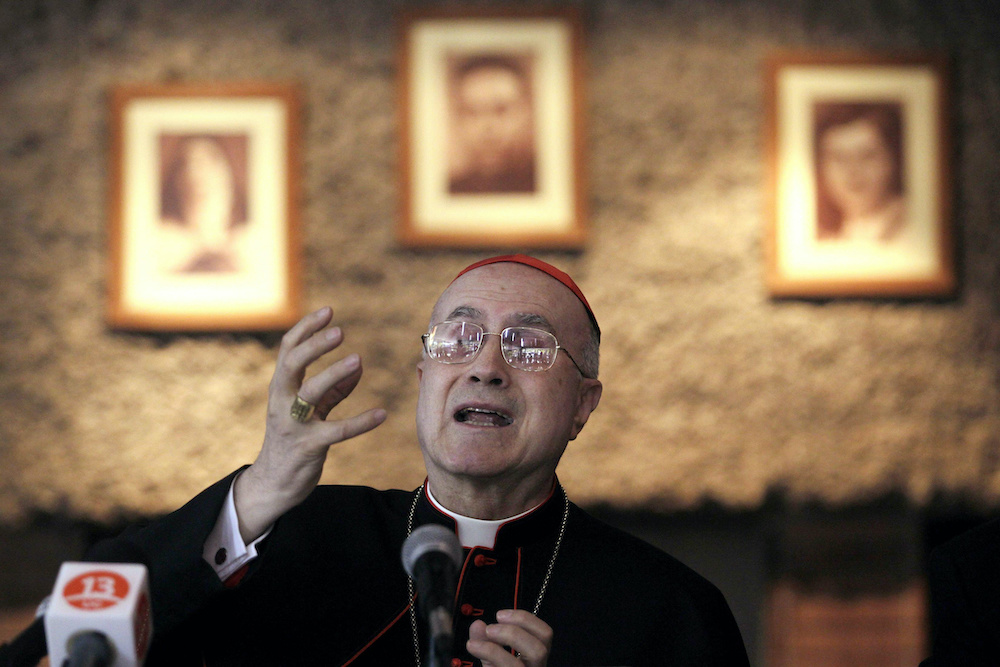
Cardinal Tarcisio Bertone, then-Vatican secretary of state, gestures during a news conference in Santiago, Chile, April 12, 2010. (CNS/Reuters/Ivan Alvarado)
Vatican diplomats in the United States
Archbishop Jean Jadot
A Belgian from a well-known family, Jadot was ordained in 1934 but served for a long period as a pastor and chaplain before entering Vatican service. Pope Paul VI appointed him the apostolic delegate to Thailand, Laos and the Malay peninsula in 1968, before moving him in 1971 to represent the Vatican in Gabon, Cameroon and Equatorial Guinea.
Jadot then served as the apostolic delegate to the U.S. from 1973 to 1980, and became known for selecting priests noted for their pastoral approach as possible candidates to be made bishops. McCarrick was first made a prelate under Jadot's tenure, becoming an auxiliary bishop of New York in 1977.
John Paul II moved Jadot to Rome in 1980, making him president of the then-Secretariat for Non-Christians. Jadot served in that role for four years, before the pontiff unceremoniously accepted his resignation shortly before his 75th birthday. Jadot was never made a cardinal; he died in 2009.
Cardinal Pio Laghi
A highly decorated, long-serving papal diplomat, Laghi first represented the Vatican as the apostolic delegate to Jerusalem and Palestine from 1969 to 1973, during which time he also served as the pro-nuncio to Cyprus and the apostolic visitor to Greece. In 1974, Pope Paul VI named Laghi as apostolic nuncio to Argentina, where he would serve six years, during the U.S.-backed "dirty war."
In 1980, Pope John Paul II moved Laghi to the U.S., where he served until 1990 and was partly responsible for making recommendations about priests that might make good bishops. During Laghi's tenure in this role, Theodore McCarrick was named the bishop of Metuchen, New Jersey, in 1981 and the archbishop of Newark in 1986.
John Paul II moved Laghi back to Rome in 1990, making him the pro-prefect, later prefect, of the Congregation for Catholic Education. Among other postings, Laghi was also serving as a member of the Congregation for Bishops in at least 2000 to 2001, when McCarrick was made archbishop of Washington, D.C.
Laghi left his full-time role at the Congregation for Education in 1999 at age 77 and died in January 2009.
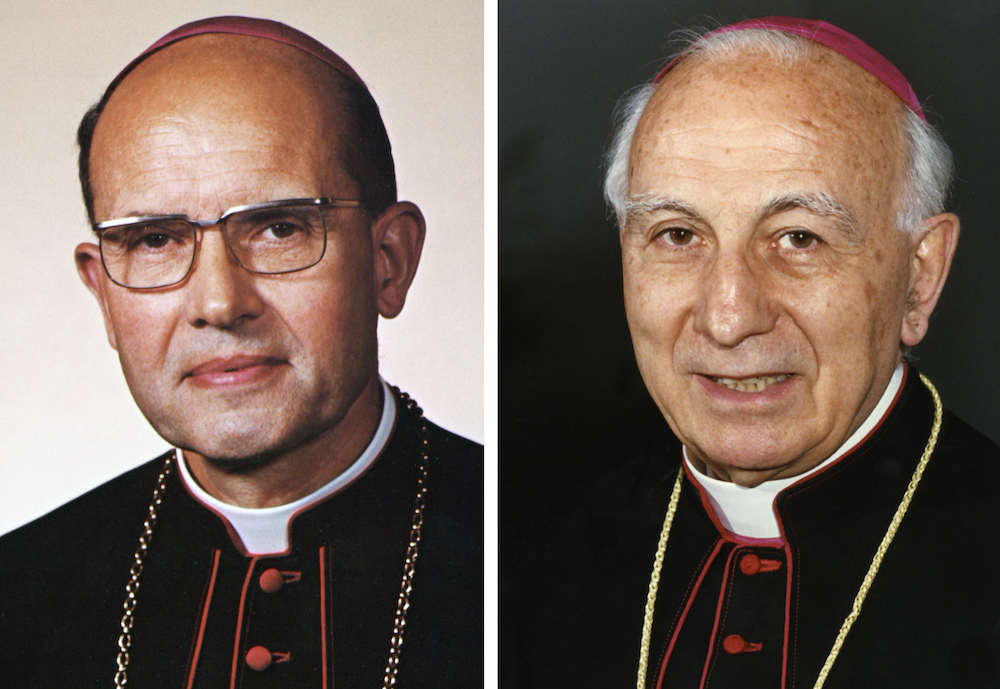
Left: Belgian Archbishop Jean Jadot, former apostolic delegate in the United States, pictured in an undated photo; Right: Italian Cardinal Pio Laghi, former Vatican nuncio to the United States, pictured in an undated photo. (CNS)
Archbishop Gabriel Montalvo Higuera
A Colombian priest, Montalvo served in the Vatican's diplomatic service for five decades. Among his assignments: apostolic nuncio, Honduras and Nicaragua (1974-80); apostolic pro-nuncio, Algeria and Tunisia (1980-86); apostolic pro-nuncio, Yugoslavia (1986-93); president of the Pontifical Ecclesiastical Academy (1993-98).
Pope John Paul II named Montalvo nuncio to the U.S. in 1998, where he served until 2005. During Higuera's tenure, McCarrick was named archbishop of Washington, D.C., in 2000.
New York priest Fr. Boniface Ramsey has said he spoke to Montalvo in 2000 about rumors that McCarrick had been sleeping in the same bed as seminarians. Montalvo appears to have passed a letter from Ramsey detailing the allegation to officials at the Secretariat of State, according to later correspondence making reference to the Vatican's knowledge of Ramsey's report.
Montalvo died from lung cancer in 2006.
Figures from the Congregation for Bishops
Cardinal Sebastiano Baggio
An Italian priest from the Veneto region, Baggio had a long career in the Vatican's diplomatic service, serving as: apostolic nuncio, Chile (1953-59); apostolic delegate, Canada (1959-64); and apostolic nuncio, Brazil (1964-69).
Pope Paul VI made him a cardinal in 1969 and appointed him as the archbishop of Cagliari, on the Italian island of Sardinia. Paul later made Baggio prefect of the Congregation for Bishops, where he served from 1973 to 1984.
McCarrick's first two appointments as bishop came during Baggio's time at the Congregation for Bishops: as auxiliary bishop of New York in 1977 and as bishop of Metuchen, New Jersey, in 1981.
After leaving the Congregation for Bishops, Baggio served as the patron of the Sovereign Military Order of Malta from 1984 until his death in 1993.
Cardinal Bernardin Gantin
A priest from the western African nation of Benin, Gantin was appointed the archbishop of Cotonou by Pope John XXIII in 1960. Pope Paul VI brought him to Rome as the second president of the Pontifical Council for Justice and Peace and made him a cardinal in 1977.
Pope John Paul II appointed Gantin as the prefect of the Congregation for Bishops in 1984, where he remained until 1998. McCarrick was appointed archbishop of Newark in May 1986.
Gantin was the first, and so far only, non-European cardinal to serve as dean of the College of Cardinals, holding that role from 1993 to 2002. He died in 2008.
Cardinal Lucas Moreira Neves
A member of the Order of Preachers (Dominicans) from Brazil, Neves was appointed by Pope John Paul II as the secretary (number-two official) for the Congregation for Bishops and served in that role from 1979 to 1987, before being named Archbishop of São Salvador, in the Brazilian state of Bahia.
Neves later returned to Rome as the prefect of the Congregation for Bishops in 1998, but only served in the position for two years (until September 2000) and died in 2002.
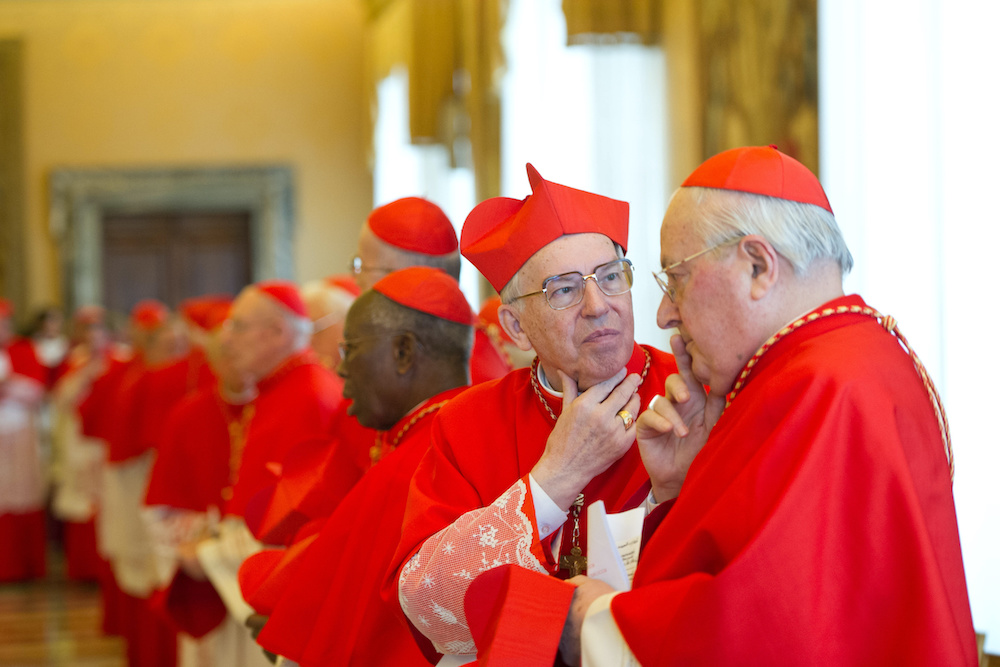
Cardinals Giovanni Battista Re and Angelo Sodano talk after Pope Benedict XVI announced his resignation in Latin during a meeting of cardinals at the Vatican, Feb. 11, 2013. (CNS/L'Osservatore Romano)
Cardinal Giovanni Battista Re
The son of an Italian carpenter in Italy's northern region of Brescia, Re began service as a member of the Vatican's bureaucracy in 1963, continuing until his retirement in 2010. Among his major positions: secretary, Congregation for Bishops (1987-89); substitute for general affairs, Secretariat of State (1989-2000); prefect, Congregation for Bishops (2000-2010).
Re was appointed by Pope John Paul II as head of the Congregation for Bishops, on Sept. 16, 2000. McCarrick was named archbishop of Washington on Nov. 21, 2000.
Re also served as the vice-dean of the College of Cardinals from 2017 to 2020, and was elected dean of the College following Sodano's resignation from the position.
US cardinals with influence
Cardinal Joseph Bernardin
The son of Italian immigrants in South Carolina, Bernardin was ordained a priest in 1952 and first served some 14 years in various roles in the Charleston Diocese. He was first appointed a bishop by Pope Paul VI, who named him auxiliary bishop of Atlanta in 1966, and then archbishop of Cincinnati in 1972.
Bernardin would later come to national prominence as archbishop of Chicago, where he was appointed to serve by Pope John Paul II in 1982. John Paul made him a cardinal in 1983.
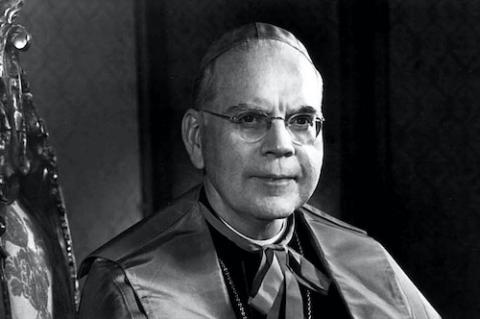
Cardinal Terence Cooke, archbishop of New York from 1968 until his death in 1983, is pictured in an undated photo. (CNS)
Bernardin was a member of the Congregation for Bishops as an archbishop for at least the years 1977 to 1978, when McCarrick was made an auxiliary bishop of New York, but he was no longer a member by 1981. Bernardin died from pancreatic cancer in 1996.
Cardinal Terence Cooke
Born to Irish parents in New York City, Cooke was the rare U.S. priest who served nearly his entire career in his home city and was even made the leader of his home diocese.
Ordained a priest in 1945 by Cardinal Francis Spellman, Cooke was first appointed an auxiliary bishop of New York by Pope Paul VI in 1965. Two years later, following Spellman's death in 1967, Paul named Cooke archbishop.
Cooke was a member of the Congregation for Bishops from at least 1977 to 1982, during which period McCarrick was made an auxiliary bishop of New York and the bishop of Metuchen, New Jersey.
Cooke, who suffered from leukemia for nearly 20 years, died in 1983.
Cardinal William Baum
Born in Texas, Baum moved as a child with his mother to Kansas City, Missouri, following the unexpected death of his father. Entering the now-closed St. John's Minor Seminary at age 14, Baum began a distinguished career that would see him become the longest-serving U.S. cardinal as yet in history.
Ordained a priest in 1951, Baum first served as a pastor in Kansas City before earning a doctorate in theology at Rome's Pontifical University of St. Thomas Aquinas (the Angelicum) in 1958. During the 1962 to 1965 Second Vatican Council, Baum served as a peritus, or theological advisor, to Kansas City, Missouri, Bishop Charles Helmsing, in which capacity he helped draft the council's decree on ecumenism.
In 1970, Pope Paul VI named Baum the bishop of Springfield-Cape Girardeau, Missouri, and then in 1973 made him the Archbishop of Washington, D.C. Paul made Baum a cardinal in 1976. In 1980, Pope John Paul II brought Baum to the Vatican, where he served as the prefect for the Congregation for Catholic Education until 1990. He then served until 2001 as major penitentiary of the Apostolic Penitentiary, heading up one of the Vatican's three major courts.
Baum is likely the longest-serving American member of the Congregation for Bishops in history, holding membership from at least 1981 until Nov. 22, 2001, meaning he was involved in three of four of McCarrick's appointments as bishop.
Baum died in 2015.
Cardinal John O'Connor
A Philadelphia native, O'Connor was ordained in 1945. Serving as a Navy chaplain during the Korean War, he would later first come to some prominence as a rear admiral and chief of chaplains of the Navy in 1975.
Pope John Paul II first appointed O'Connor a bishop in 1979, making him an auxiliary for the then-Military Vicariate for the United States. John Paul moved O'Connor to Scranton, Pennsylvania, in 1983, and then named him the archbishop of New York following the death of Cardinal Terence Cooke. In New York, O'Connor became known for his passionate defenses of organized labor and for his occasional critiques of U.S. military action abroad.
O'Connor was a member of the Congregation for Bishops from at least 1986 until his death on May 3, 2000, meaning his membership likely overlapped with McCarrick's appointment as archbishop of Metuchen, New Jersey.
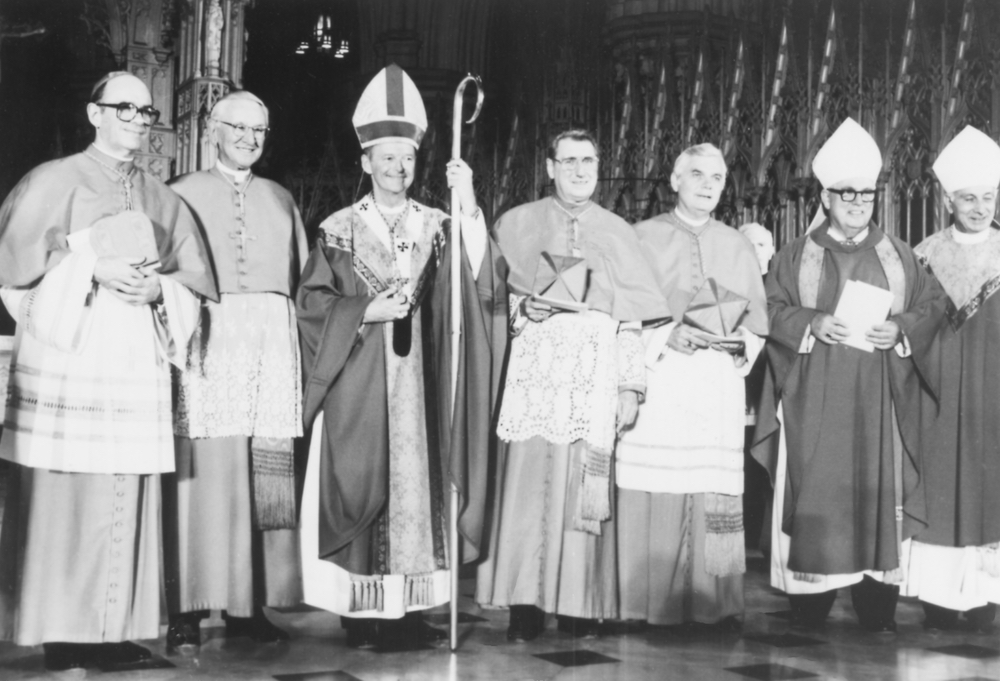
In 1986, following his installation as archbishop of Newark, New Jersey, Archbishop Theodore McCarrick is flanked by, from left, Chicago Cardinal Joseph Bernardin, Philadelphia Cardinal John Krol, New York Cardinal John O'Connor, Boston Cardinal Bernard Law, retiring Newark Archbishop Peter Gerety, and apostolic pro-nuncio Archbishop Pio Laghi. (CNS/D.J. Zehnder)
Cardinal James Stafford
Born to Irish descendants in Baltimore, Stafford originally intended to pursue a career in medicine but entered the seminary in 1952. Ordained a priest in 1957, he earned a licentiate in theology from the Pontifical Gregorian University as well as a master of social work degree from the Catholic University of America. Stafford's first major role was as director of Baltimore's Catholic Charities office from 1966 to 1976.
In early 1976, Pope Paul VI appointed Stafford an auxiliary bishop of Baltimore. In 1981, Pope John Paul II made Stafford the bishop of Memphis, Tennessee, and then in 1986, the archbishop of Denver.
John Paul II brought Stafford to Rome in 1996 as the president of the Pontifical Council for the Laity and made him a cardinal in 1998. He then served from 2003 to 2009 as major penitentiary of the Apostolic Penitentiary, heading up one of the Vatican's three major courts.
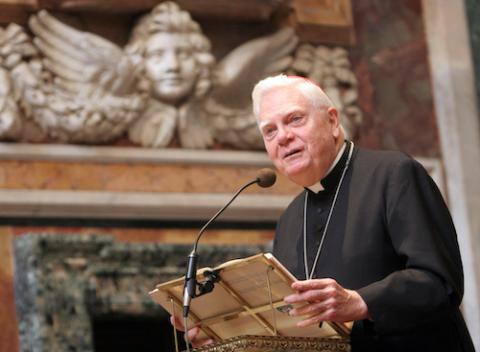
Cardinal Bernard Law is seen addressing a group of pilgrims at the Basilica of Santa Maria Maggiore in Rome, November 2007. (CNS/Long Island Catholic/Gregory A. Shemitz)
Stafford was a member of the Congregation for Bishops for at least the years 2000 to 2001, when McCarrick was appointed Archbishop of Washington, D.C. The cardinal, who retired in 2009 at age 77, lives in Rome.
Cardinal Bernard Law
Appointed the archbishop of Boston in 1984 by Pope John Paul II, Law would become one of the most disgraced figures in the history of American Catholicism in 2001, when The Boston Globe's spotlight investigation revealed his archdiocese's pattern of keeping priests known to be child abusers in ministry.
Resigning from his role in Boston in late 2002, Law moved to Rome, where John Paul made him archpriest of the Basilica of Santa Maria Maggiore.
Law was a member of the Congregation for Bishops from at least 2000 to 2001, when McCarrick was appointed Archbishop of Washington, D.C. He died in 2017.
Archbishops of Washington, DC
Cardinal James Hickey
A native of Michigan, Hickey first served throughout the Midwest before becoming the second-longest-serving archbishop of Washington. Ordained a priest in 1946, Hickey earned doctorates in both canon law (from the Pontifical Lateran University in 1950) and theology (from the Pontifical University of St. Thomas Aquinas in 1951).
Returning to the U.S. from studies, Hickey served as secretary to Saginaw, Michigan, Bishop Stanislaus Woznicki, whom he would also advise as a peritus, or theological assistant, during Vatican II, 1962 to 1965.
Pope Paul VI first made Hickey an auxiliary bishop of Saginaw in 1967, and then bishop of Cleveland in 1974. Pope John Paul II promoted Hickey to archbishop of Washington in 1980, and made him a cardinal in 1988.
Hickey was replaced as archbishop in November 2000 by McCarrick. Hickey died in 2004.
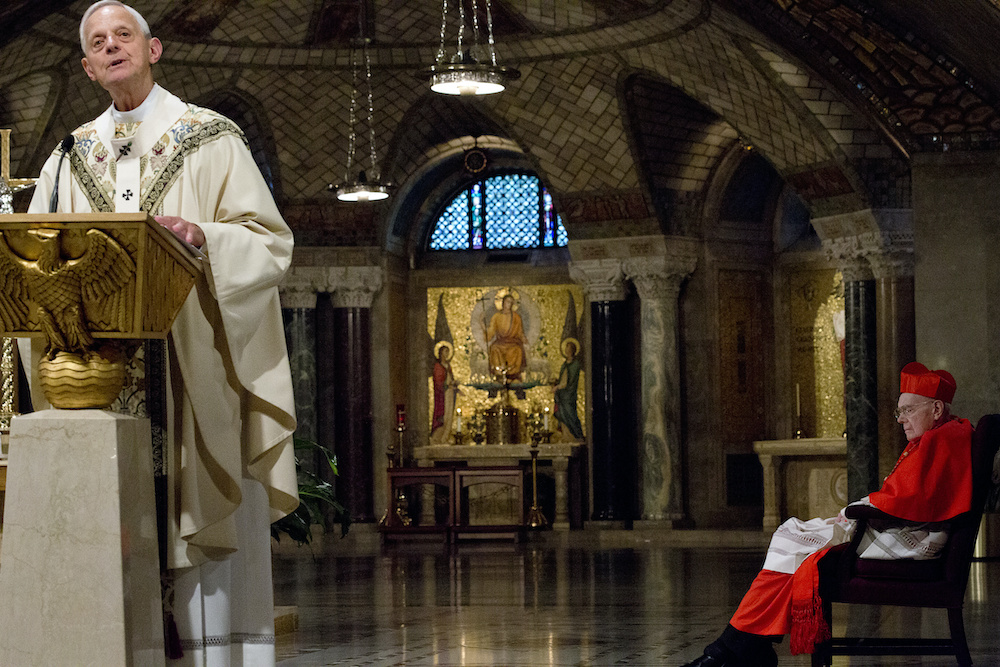
Cardinal Donald Wuerl of Washington delivers the homily during a Mass for peace in Syria and the world Sept. 7, 2013, in the Crypt Church at the Basilica of the National Shrine of the Immaculate Conception in Washington, D.C. At right is Cardinal William Baum, retired archbishop of Washington, who served from 1973 to 1980. (CNS/Tyler Orsburn)
Cardinal Donald Wuerl
A Pittsburgh native, Wuerl had a distinguished early career as a priest but a more difficult experience in his first appointments as bishop before he was ultimately named Archbishop of Washington in 2006.
After Wuerl's 1966 ordination to the priesthood, Pittsburgh Bishop John Wright appointed the young cleric his secretary and took him to Rome after being appointed to lead the Congregation for Clergy in 1969.
Wuerl stayed with Wright until the latter's death in 1979 and then returned to Pittsburgh as rector of St. Paul Seminary from 1981 to 1985.
At the age of 45 in 1985, Wuerl was appointed by Pope John Paul II as an auxiliary bishop of Seattle, where he and Archbishop Raymond Hunthausen came into conflict. Hunthausen, who had been subject to a Vatican investigation over alleged doctrinal issues, was not informed that Wuerl had been given special faculties over several areas of leadership in Seattle.
In 1988, Wuerl was appointed bishop of Pittsburgh. His 18-year tenure in the city, originally praised, has become the subject of criticism after the 2018 release of a Pennsylvania grand jury report examining the responses of six dioceses in the state to clergy abuse, including Pittsburgh. Chancery officials in several of the dioceses have pointed to errors, or significant gaps in information, that led the report to mistaken conclusions.
Pope Benedict XVI appointed Wuerl to replace McCarrick in Washington in 2006 and made him a cardinal in 2010. Although Wuerl initially denied knowing until 2018 of any specific allegation of abuse made against McCarrick, he later acknowledged that he had spoken to Vatican nuncio Archbishop Montalvo about one allegation in 2004.
Wuerl has served as a member of the Congregation for Bishops on appointment by Pope Francis since 2013. He is expected to resign that role on Nov. 12, 2020, when he turns the mandatory retirement age of 80.
[Joshua J. McElwee is NCR Vatican correspondent. His email address is jmcelwee@ncronline.org. Follow him on Twitter: @joshjmac.]
